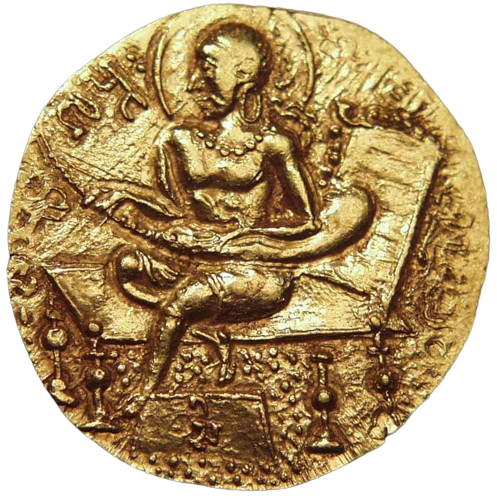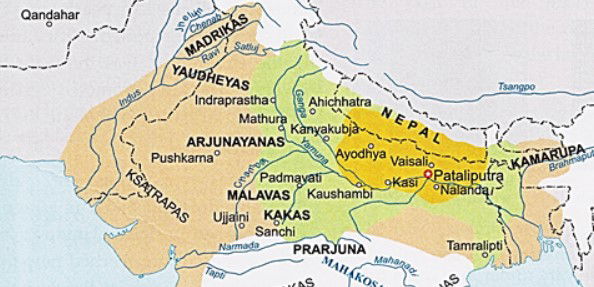Samudragupta’s Conquests in the West


Samudragupta needs no introduction. Easily one of the greatest conquerors India produced, with Chandragupta Maurya the only king before him who can match his scale, he was the real founder of Gupta power. His successors were illustrous but except for his son Chandragupta, I doubt anyone would have come near to him. Allahabad Pillar Inscription, written by his minister Harisena is considered to be the gold standard. There are many lines open to interpretation in that like the success of his Southern expedition, the reference to the Naga troika – Achytanandi, Ganapatinaga and Nagasena twice in the inscription with some claiming it to be assertion of the importance of their defeat and the others claiming it to be a rebellion against the Guptas when Samudragupta was in the South, whether he fought the Vakatakas – and many such.
And as like the rest of his conquests, his Western conquests are also subject to interpretation. Let’s be clear. It was never about the extent of his empire. It was always about how it came to be. The lack of complete information also adds to the enigma. Let’s consider the West. Ignoring the alliance of the three Naga kings with that of the King of Kannauj(Pushpa), we would see that his realm extended far west according to the inscription –
मलवार्जुनायन-यौधेय-माद्रकाभीर-प्रार्जुन-सनकानीक-काक-खरपरिकादिभिश्चसर्व्व कर -दानाज्ञाकरण-प्रणामागमन-परितोषित-प्रचंड-शासनस्य ।
The highlighted ones for sure on the west, and going by the fact Kakas and Abhiras are in the West, it’s possible that both Prarjunas and Sanakanikas are also in the West. Not just that, coins of Kipunada, the last known Kushana king with the word Samudra are known – indicating his reach till then.

However, this is also not a point of our interest. This is just to establish how far west Samudragupta’s reign extended.
At this time, there was a sudden activity in Central Asia – a chieftain by name Kidara first attacked the Sassanids and carved his kingdom extending from Oxus to Indus. Their Indian part is a combination of the Kushana rump state and a part of the Sassanid conquests by the Indus. Kidara became an ally of the Sassanids and later, became their enemy. We know that the Sassanids allied with the Central Asian opponents of the Kidaras – possibly the White Huns and at this point, it is known that Kidara was searching for allies. Again, going by the Kipunada logic, coins of Kidara are found with the legend Samudra indicating that Kidara submitted to the Guptas. Now, the question would be, what happened after that, or more correctly, what do we know of what happened then?
SV Sohoni in his paper Samudragupta’s Expedition Against Persia(356-362 AD) proposes an interesting sequence of events. He proposes that the Western conquests of Raghu in Kalidasa’s Raghuvamsam clearly match a campaign Samudragupta’s campaigns. The relevant verses are below.
Against the Sassanids:
मत्तेभरदनोत्कीर्णव्यक्तविक्रमलक्षणम्|
त्रिकूटमेव तत्रोच्चैर्जयस्तम्भं चकार सः॥ ४-५९
Without building triumphal arches anew, raghu made Mt. trikUta alone as his lofty tower of victory since his ruttish elephants made dents on the slopes of that mountain with their tusks which, in effect, are the evident hallmarks of his valour.
पारसीकांस्ततो जेतुं प्रतस्थे स्थलवर्त्मना|
इन्द्रियाख्यानिव रिपूंस्तत्त्वज्ञानेन संयमी॥ ४-६०
Raghu then proceeded by a land route to conquer the pArasIka kings just as a self-controlled yogi possessing divine knowledge proceeds to conquer his own enemies, called his own senses.
यवनीमुखपद्मानां सेहे मधुमदं न सः|
बालातपमिवाब्जानामकालजलदोदयः ॥ ४-६१
As to how an untimely cloud removes morning sunlight from the faces of just blooming lotuses, raghu has also removed the blooming flush of wine from the lotus-like faces of yavana women when he encountered their men.
भल्लापवर्जितैस्तेषां शिरोभिः श्मश्रुलैर्महीम्|
तस्तार सरघाव्याप्तैः स क्षौद्रपटलैरिव॥ ४-६३
raghu covered the ground with the bearded heads of westerners that are cut off with spear-like arrows, as if they are the sheaves of honeycombs swarming with bees.
अपनीतशिरस्त्राणाः शेषास्तं शरणं ययुः|
प्रणिपातप्रतीकारः संरम्भो हि महात्मनाम्॥ ४-६४
And the survivors sought the protection of raghu on removing their helmets, and the anger of the generous will be readily appeased by submission, isn’t it!
Against the Huns:
ततः प्रतस्थे कौबेरीं भास्वानिव रघुर्दिशम्|
शरैरुस्रैरिवोदीच्यानुद्धरिष्यन् रसानिव॥ ४-६६
As to how the sun squeezes water with his sharp arrows like sunrays in northern solstice, raghu proceeded to north to squeeze the kings of north with his sharp sunrays like arrows.
विनीताध्वश्रमास्तस्य सिन्धुतीरविचेष्टनैः|
दुधुवुर्वाजिनः स्कन्धाम्ल्लग्नकुङ्कुमकेसरान्॥ ४-६७
raghu’s horses having refreshed themselves by rolling on the banks of River sindhu shook off the filaments of saffron stuck on their shoulders.
तत्र हूणावरोधानां भर्तृषु व्यक्तविक्रमम्|
कपोलपाटलादेशि बभूव रघुचेष्टितम्॥ ४-६८
The cheeks of huNa women glowed with embarrassment by the action of raghu in waging war with their husbands and that flush itself appeared as an index to raghu s valour.
काम्बोजाः समरे सोढुं तस्य वीर्यमनीश्वराः|
गजालानपरिक्लिष्टैरक्षोटैः सार्धमानताः॥ ४-६९
Along with the walnut trees that are bending their treetops unable to withstand the pull and push of elephants tied to them with halters, the kings of kAmboja too bent their heads down before raghu in token of their submission unable to withstand his bravery in battle.
तेषां सदश्वभूयिष्ठास्तुङ्गा द्रविणराशयः|
उपदा विविशुः शश्वन्नोत्सेकाः कोसलेश्वरम्॥ ४-७०
Large heaps of gold together with numerous thorough bred horses constantly reached the lord of kosala kingdom namely raghu, from those kAmboja kings, but pride never came near him.
The sequence of events is very convincing – first, Samudragupta defeated the Sassanids and after that, advanced North defeating the Huns. At this point, Kalidasa ends the campaign and then introduces a fresh campaign – into the Himalayas. Whether the second campaign refers to Samudragupta or his son Chandragupta is irrelevant to this discussion.
On the other hand, while Kalidasa’s description fits the only time frame of a land attack against the Sassanids(the next major engagements in the theatre happened during the reign of Skandagupta possibly in alliance with the Sassanid Yazdegerd but this event happened after Kalidasa) and is realistic enough and fits the general tone of the politics of the era so perfectly that one should give it some serious credence.
In fact, all this rests around the words Daivaputra Shahi Shahanushahi Saka Murunda in the Allahabad Pillar Inscription – while people generally equated Shahanushahi with the Kushana rump state, Sohoni seems to have equated them with the Sassanid regnal title of Shahanshah. There is a slight problem though – Harisena uses Saka Murunda – the Saka Lords while Kalidasa uses Hunas. Well, there is not much clarity historically between Turks, Mongols, Sakas, Huns and even the Tibetans! Different languages used different words for these races – and in most of the cases, overlapping.
In essence, one can present a decent case that Samudragupta actually engaged and defeated the Sassanids and ironically, the description of his fight with the Sassanids seems to be more convincing than that of his fight with the Pallavas!!
DISCLAIMER: The author is solely responsible for the views expressed in this article. The author carries the responsibility for citing and/or licensing of images utilized within the text.
1 Comment
You must be logged in to post a comment.

There is no ” gupta”
Their coins say, they were ” Jutasya”- i.e Of the Jats.
Jatm jutm does not trasnlate intoa soft ‘ th’
Their clan name is Dharan , Jat clan.
Chandra was aJat of teh maur clan or of jats